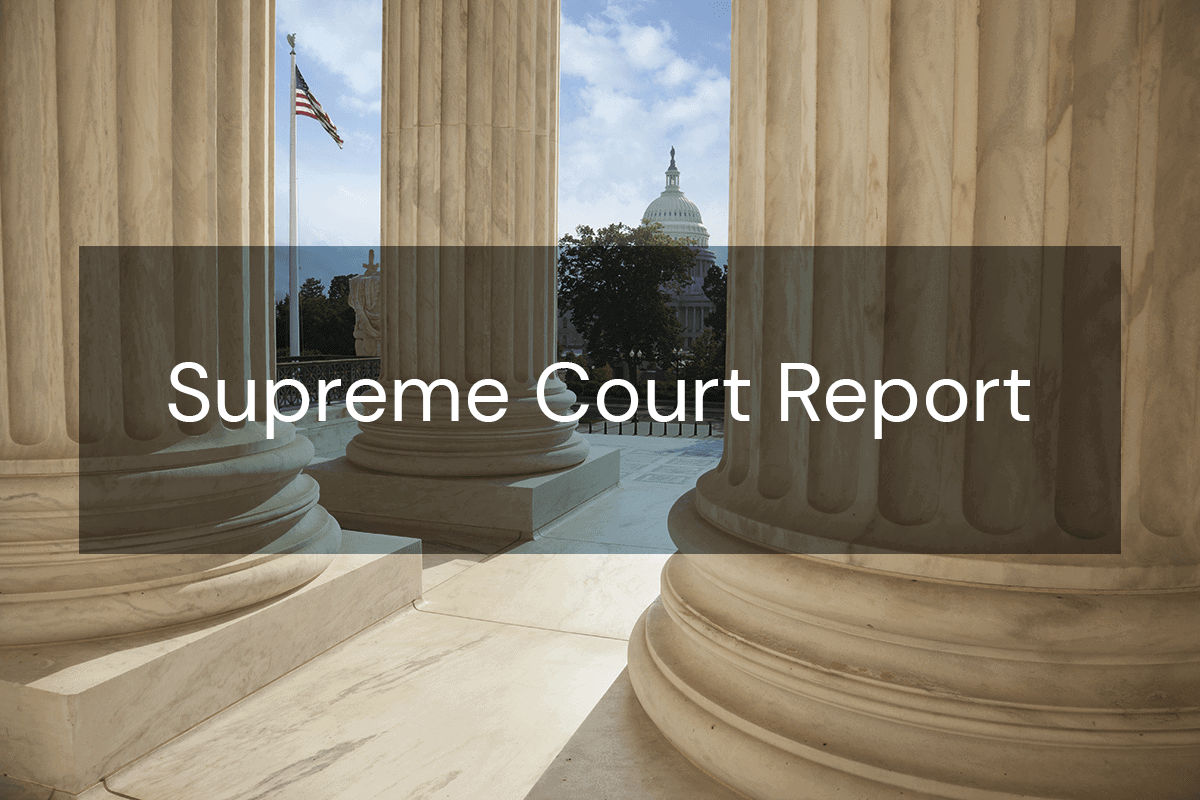-
 Director, Center for Supreme Court AdvocacyNational Association of Attorneys General
Director, Center for Supreme Court AdvocacyNational Association of Attorneys General

This Report summarizes cases granted review on October 29 and November 5, 2021 (Part I).
Cases Granted Review: West Virginia v. EPA, 20-1530; North American Coal Corp. v. EPA, 20-1531; Westmoreland Mining Holdings, LLC v. EPA, 20-1778; North Dakota v. EPA, 20-1780
West Virginia v. EPA, 20-1530; North American Coal Corp. v. EPA, 20-1531; Westmoreland Mining Holdings, LLC v. EPA, 20-1778; North Dakota v. EPA, 20-1780. Under review is a D.C. Circuit decision holding that the Trump administration’s repeal and replacement of the Obama administration’s Clean Power Plan was arbitrary and capricious. Section 111(b) of the Clean Air Act directs EPA to establish “standards of performance” for new stationary sources. 42 U.S.C. §7411(b)(1)(B). A “standard of performance” is a “standard for emissions of air pollutants which reflects the degree of emission limitation achievable through the application of the best system of emission reduction which (taking into account the cost of achieving such reduction and any nonair quality health and environmental impact and energy requirements) the Administrator determines has been adequately demonstrated.” §7411(a)(1). For existing sources, Congress created a cooperative federalism program in Section 111(d). §7411(d). EPA identifies the “best system of emission reduction” available for designated categories of sources, then promulgates a “procedure” for states to submit standards of performance for the individual sources within their borders. §7411(d)(1). The states follow that procedure to set particular “standard[s] for emissions of air pollutants,” which “reflect[]” the best system of emission reduction but can be modified based on source-specific factors like a facility’s “remaining useful life.” §7411(a)(1), (d)(1).
In October 2015, the Obama administration’s EPA finalized the Clean Power Plan rule to address climate change. Relying on §7411(d), EPA determined that, with respect to CO2 emissions from power plants, the best system would consist of three “building blocks”: (1) improving heat rate (efficiency) at coal-fired plants; (2) substituting electricity generation from gas-fired plants for generation from coal-fired plants; and (3) substituting generation from zero-emitting sources for generation from coal-fired and gas-fired plants. In the D.C. Circuit’s words, “[t]hose second and third methods of emission control are often referred to as ‘generation shifting’ because the reductions occur when the source of power generation shifts from higher-emission power plants to less-polluting sources of energy.” According to West Virginia’s petition, “[t]he upshot is that most coal- and gas-fired plants would have been required to reduce operations and invest in alternate types of generation, or (most often) subsidize their competitors’ or out-of-state companies’ investments. Some plants would have been forced to close down.” Twenty-seven states and numerous other parties challenged the Clean Power Plan in the D.C. Circuit. The D.C. Circuit refused to stay the Plan pending the proceedings, but the Supreme Court, in February 2016, stayed the Plan. After the 2017 change in presidential administrations, the D.C. Circuit placed the case in abeyance, and eventually dismissed the case in 2019 when EPA replaced the Clean Power Plan with a new rule.
Specifically, on July 8, 2019, the Trump administration’s EPA repealed and replaced the Clean Power Plan. EPA determined that the Clean Power Plan “significantly exceeded” its authority under Section 111. In its view, Section 111 is limited by its terms to systems of controls that can be applied successfully only at individual sources, and the Clean Power Plan unlawfully departed from that unambiguous constraint. EPA also maintained that clear-statement canons bolstered its view, and that the Clean Power Plan would have run afoul of the Clean Air Act’s cooperative federalism framework and significantly infringed areas of traditional state sovereignty. EPA adopted new Section 111(d) guidelines for existing coal-fired power plants, called the Affordable Clean Energy (ACE) rule. The ACE rule was built on the same threshold determination that measures achievable only on a regional or grid-wide level cannot be a “system of emission reduction.” The ACE rule imposed new guidelines that relied solely on efficiency improvements to individual coal-fired plants. A group of states, municipalities, organizations, and power companies challenged the repeal of the Clean Power Plan and adoption of the ACE rule. The D.C. Circuit issued a 2-1 decision vacating and remanding the Clean Power Plan repeal and ACE rule. 985 F.3d 914.
The D.C. Circuit observed that “the sole ground on which the EPA defends its abandonment of the Clean Power Plan in favor of the ACE Rule is that the text of Section 7411 is clear and unambiguous in constraining the EPA to use only improvements at and to existing sources in its best system of emission reduction.” The court concluded, however, that “traditional tools of statutory interpretation reveal nothing in the text, structure, history, or purpose of Section 7411 that compels the reading the EPA adopted in” repealing the Clean Power Plan and adopting the ACE Rule. The court likewise concluded that neither the “major questions” doctrine nor the federalism canon supports that reading. All told, found the court, “Congress imposed no limits” in Section 111 other than directives to consider costs, nonair health and environmental impacts, and energy requirements. The court therefore held that Section 7411 “does not unambiguously bar a system of emission reduction that includes generation shifting.” Having held that EPA had “erred in concluding Section 7411 unambiguously requires that the best system of emission reduction be source specific,” the court also “reject[ed] the ACE Rule’s exclusion from Section 7411(d) of compliance measures it characterizes as non-source-specific.” The court of appeals concluded that, because EPA had relied on “the erroneous legal premise that the statutory text expressly foreclosed consideration of measures other than those that apply at and to the individual source,” both the Clean Power Plan repeal and the ACE Rule should be vacated.
The states led by West Virginia assert that the D.C. Circuit “held that a rarely used, ancillary provision of the Clean Air Act grants an agency unbridled power—functionally ‘no limits’—to decide whether and how to decarbonize almost any sector of the economy.” West Virginia maintains that the Clean Power Plan fails two clear-statement canons. First, “courts presume that ‘Congress intends to make major policy decisions itself’ and does not lightly assign ‘major lawmaking authority . . . to the Executive Branch.’” Second, “courts presume Congress does not intend to make ‘a dramatic departure’ from the Constitution’s state-federal balance ‘[a]bsent a clear statement of that purpose.’” West Virginia continues, “[t]he fact that Congress did not clearly authorize the majority’s near-boundless view of agency power should have ended the analysis. But in any event, no fair construction of Section 111 supports the sweeping holding below, either.” Finally, West Virginia argues that “if the majority is right that Congress placed functionally ‘no limits’ on EPA’s authority, then Section 111 would raise serious non-delegation concerns.” The Court granted certiorari even though, as the briefs in opposition pointed out, the Biden administration EPA abandoned the ACE rule and announced that it is undertaking a new rulemaking to regulate CO2 emissions from existing power plants, which will supersede the abandoned rule but will not be the Clean Power Plan.
[Editor’s note: Some of the language in the background section of the summary above was taken from the petition for writ of certiorari and brief in opposition.]



